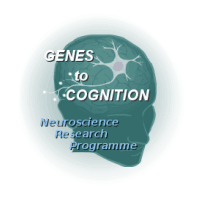G2C::Synapse Proteomics
Introduction
Over the past decade Professor Seth Grant's laboratory and the Genes to Cognition Programme, have pioneered and subsequently refined and developed the use of proteomics in the nervous system (neuroproteomics) as a tool to dissect the composition and function of the mammalian synapse.
These studies have significantly advanced our knowledge of the protein composition of brain synapses, focussing on the postsynaptic compartment, to date finding and reporting over two thousand distinct proteins that make up the complex receptor and signal transduction machinery of the excitatory postsynaptic nerve terminal 11780971.
Knowledge of this 'molecular catalogue' of synaptic components has been enormously useful to the neuroscience community as a whole, acting as starting point for many avenues of neurobiological and genetic research. We ourselves have employed this 'synaptic parts list' to apply systems biology approaches to model the function and organisation of the synapse 16738568, and initiate a large scale mouse knockout and phenotyping programme, to determine the role of individual proteins within the network of the glutamatergic NMDA receptor and postsynaptic density (PSD) complex 14630221. Integration of our model organism findings with those observed in humans in a clinical research genetics setting, has allowed us to build up an overall model of synaptic function in health and disease, and survey human brain diseases resulting from derangements in synaptic proteins see 22409856 which we aim to freely provide to the world via our web database, G2Cdb.
Receptor Complex Proteomics
Our first neuroproteomics papers combined immunoblotting and mass spectroscopy to characterise the protein composition of the the NMDA receptor complex 14630221; 11279284. This complex, known to play key a role in synaptic plasticity at excitatory synapse in the mammalian system was found to comprise of 77 proteins built up of receptor, adaptor, signalling, cytoskeletal and novel proteins. These studies substantially extended the repertoire of proteins involved in fast excitatory signalling in the mammalian brain, and drew initial attention to synapse-linked genetic disorders of the human nervous system.
This characterisation of the NMDA receptor complex was extended in a comprehensive study 16635246 reporting the proteomic characterisation of many of the receptor complexes of the postsynaptic terminal, including the NMDA, metabotropic glutamate receptor 5 (mGluR5) and 2-amino-3-(3-hydroxy-5-methyl-isoxazol-4-yl)propanoic acid (AMPA) receptor complexes, as well as the postsynaptic density (PSD). Utilizing improving mass spectroscopy instrumentation and techniques, we found we could now detect 186 proteins in the NMDA receptor (NRC/MASC) complex.
Phosphoproteomics
Protein phosphorylation and its regulation is widely recognised to involved in many, if not all aspects of nervous system function. These include neuronal development, nervous system signalling, synaptic plasticity and various pathological processes. Given the number of potential protein phosphorylation sites on even a single synaptic protein, elucidating how dynamic phosphoregulation contributes to say trans-synaptic signalling and brain processes in a complex as large as the NMDA receptor, using conventional low-throughput biochemical detection techniques is clearly impossible.
We embarked upon research to develop methods employing proteomic techniques to detect protein phosphorylation state at a very large scale. Combining metal-affinity chromatography with mass spectrometry allowed us characterise hundreds of known and novel phosphorylation sites in parallel from hundreds of synapse proteins 15572359; 16118397; 19401593.
Targeted TAP-tagging technology for protein isolation
Proteomic analysis of neuronal receptor complexes, as we have described above depends upon biochemical isolation of the complexes prior to their analysis. The harsh conditions and chemicals employed often employed for the isolation step will almost certainly alter and denature these protein complexes from their native state.
Taking the lead from yeast biologists, we genetically engineered protein affinity purification tags into proteins of key interest in mice, using stem cell manipulation technology. Using this tandem affinity purification (TAP) tagging technique we isolated the PSD-95 scaffolding protein complex, a core organiser of the NMDA receptor complex at the postsynaptic density 19455133. Under these conditions we found PSD-95 associated with ~ 300 proteins, substantially more than prior investigations, and significantly enriched in schizophrenia susceptibility genes.
Human Brain Proteomics
Our most recent proteomics studies have focussed on applying these neuroproteomic techniques to characterise neuronal receptor multi-protein complexes isolated from human brain tissue specimens. Our motivations for doing this include developing a better understanding of the causes of human psychiatric and neurological disorders, and also to shed light on human brain evolution, by using comparative genomics approaches.
Proteomic analysis of human PSDs was carried out using brain tissue obtained from patients undergoing brain surgery. The proteomic mass spectroscopy yielded 1461 proteins, each one encoded by a different gene found in human synapses as part of the PSD. This made it possible, for the first time, to systematically identify the diseases that affect human synapses. Additionally we found, by examining the evolutionary rates of these synaptic proteins, that the human PSD complex is highly evolutionarily constrained, more so than all cellular organelles examined, and indeed the human brain as a whole 21170055.
Comparing this set of human PSD proteins to those we identified from the PSD using identical proteomic methods and instrumentation from murine brain tissue, has allowed us to make a critical evaluation of the use of mice as experimental models for human brain function and disorders which focus on the synapse 23071613
